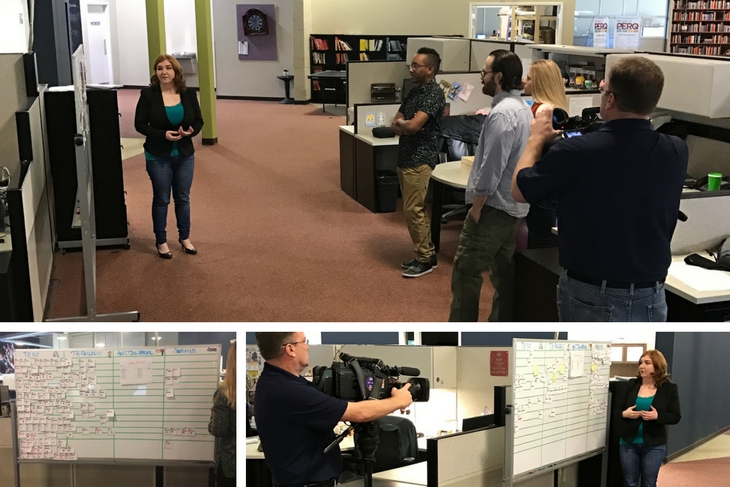Agile Marketing saved PERQ from daily ‘Eat That Frog’ frenzy
It’s been about 2 years since the Marketing Department at PERQ began to leverage Agile Marketing. Although we were off to a bumpy start, our willingness to roll with the punches helped our team to evolve and become an even more crucial component of PERQ’s overall business strategy.
For those unfamiliar with Agile Marketing, Logan Mallory of Workfront describes it as “a tactical marketing approach in which teams identify and focus their collective efforts on high value projects, complete those projects cooperatively, measure their impact, and then continuously and incrementally improve the results over time.”
Around the time PERQ came to be (we were previously three different entities), our marketing department was starting to come into its own — thanks in part to our fearless Marketing Director, Muhammad Yasin. During the first year and a half of PERQ’s conception, things were, what I guess you could say, a little scattered. Although we were quite productive (PERQ did launch its brand without a hitch, after all), there were some things that we could have been done better.

As a team, it was basically “every man for himself.” Each individual was assigned specific tasks, and they were expected to get those tasks done. Their manager would set expectations individually, and everyone worked really hard to get their work done. Each of us had one-on-ones with our manager to get caught up — and they would go something like this:
“Are you getting your work done?”
“Yep!”
“Rad. Keep doing that.”
Okay, so I’m completely exaggerating how those conversations went. They were, in all actuality, very productive meetings! But prior to implementing agile marketing, it felt like some of us were ‘flying by the seat of our pants.’ As a department and as individuals, we had quarterly goals and several initiatives that we’d focus on. However, the only real tangible evidence of many of those projects was via Word documents, Excel spreadsheets, email conversations, chat conversations and meetings. Things were literally scattered!
The wheels were turning on several different projects, but there was no singular way of documenting our progress to our managers and to the rest of the team. This left many of us feeling a little lost about what stage in the process some of us were in with certain projects, and lots of questions would arise: “Were we supposed to be part of this project or were we supposed to enter later? What would be my contribution to this project? How far along are we in this project? Is your portion of the project complete so I can get started?” In a nutshell, our progress on key projects and initiatives was slowing down due to a lack of transparent communication and structure.
At the beginning of January 2015, the PERQ Marketing department officially integrated Agile Marketing. Two years, 6,260 tasks and approximately 3,600 story points later, Agile Marketing has become absolutely crucial to the productivity and health of not only our marketing team, but the health of our entire organization.

About a year ago, I took the reigns as department scrum master (the person who manages the agile process), and that allowed me to gain even greater insight into how Agile Marketing has impacted our team. Here are some of those observations:
You Realize the Major Impact Individual Team Members Have
Before becoming the official scrum master, simply being a participant of Agile Marketing gave me transparency into what literally everyone on my team was working on — and I thought that was pretty amazing.
While I was aware that everyone on our team was a hard worker, I didn’t exactly have a full understanding of what everyone was doing. As time progressed, it became pretty clear that my teammates were just as confused about what I did too!
When you become a scrum master for a team, you become suddenly more aware of everything around you. Because you’re essentially managing the way a team communicates with one another (in daily stand-ups, sprint planning and retrospective), you need to understand each individual’s contributions on a deeper level in order to guide them in the right direction. For example: If an individual contributor finds that they’re overcapacity (meaning they have too much to do), you’ll have to discuss what it is they want to cut from their sprint.
Whenever I would cut down or even add tasks to a person’s “to-do” list each sprint, I’m made more aware of how important their work is — both to their teammates and to the organization as a whole. This was particularly evident when one of my favorite teammates left to seek out amazing new opportunities in Hong Kong. His presence and his departure was felt by everyone in the entire company. Even if it doesn’t seem like, EVERYONE’s contributions matter.
Team Retrospective Is Completely 100% Necessary
Even though the majority of us work with one another on several projects, a lot of us on the marketing team work on our own to get certain tasks complete. This basically means that we, as a team, don’t get a whole lot of time together — which is why it’s so important when we DO get together. As scrum master, I do my absolute best to make sure that we’re all on the same page during our daily stand-ups — that we’re keeping side discussions to a minimum and that we’re actively paying attention to what everyone is up to.
It’s especially crucial for me to enforce these “rules” during our team retrospective — the hour or so we give ourselves to reflect on the previous 2 weeks of a marketing sprint.
Although our team could probably survive and do relatively okay just mapping out our 2-week’s worth of work, holding a meeting for retrospective provides our team with tremendous awareness and understanding. Being able to reflect on everything in the previous sprint (positive or negative), gives us an opportunity to learn and move forward even stronger than before.
The majority of the “lessons learned” convert into action items that we transfer over to future sprints. With retrospectives, we’re able to avoid potentially detrimental mistakes moving forward — and at times, change entire processes around to make them more productive. This is why retrospective is so crucial to our success.
Structure Keeps People From Feeling Overwhelmed
If you work in tech, there’s little to no doubt that there will be times in the near future where you’ll feel a little overwhelmed by the number of tasks that need to be completed within a two week period (or however long your sprints are).
Even though we’re what I personally like to call a “lean team” and we typically fill up our plates pretty heavily each sprint, the simple act of planning out the next two weeks is comforting — especially if we’re able to prioritize each of our projects and tasks while we’re all together.
Prior to using Agile, I would often refer to the “Eat That Frog” method of productivity. While it’s proven to be quite useful for some (and useful for me, at some point), I still felt like everything was a priority … and simply taking down the “ugliest” task didn’t really help calm my nerves. Providing our entire team with a two-week time period to get important stuff done basically forces us to focus on a limited number of items.
There’s no real thinking months ahead (unless it’s specifically a planning task) — there’s just execution of that work. What’s particularly valuable about mapping out our work in a group setting is that individual contributors can (and often will) offer insight into that execution, or more often than not, offer their assistance. These constraints and this type of work structure make for great team work.
At the very beginning of 2017, we as a team decided that, after two full years of Agile Marketing, it was time change things up. One thing we recently implemented into our retrospective were professional development discussions. Going forward, our hope is that these discussions will bring new ideas to the table and give our team members a different perspective on life.
What’s really nifty about Agile Marketing is that there’s no one-way of doing it. Depending on who is on your team, and who is in charge, it can really be anything you want it to be. So far, the changes have been really insightful — and I can’t wait to see how all of us change in the future.
Is your marketing or product team thinking of trying out Agile? What do you hope to accomplish?
 About the Author
About the Author
Felicia Savage is a content marketing specialist and online community builder at PERQ, an engagement technology company that focuses on helping brands generate excitement, educate their consumers, and provide shopping assistance to their consumers using interactive experiences.



